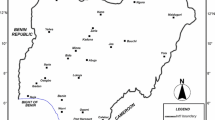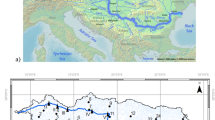Abstract
Daily precipitation totals at 55 sites were used to investigate geographic variability in winter (DJF) rainfall over Cumbria, NW England, over an 11-year period. Winter is the wettest season (>800 mm in the mountainous Lake District), with rainfall mechanisms closely linked to North Atlantic forcing. The Lamb weather type catalogue was used to identify rainfall distributions under different wind directions. Precipitation magnitude over Cumbria is much more sensitive to a change in wind direction than the geographic pattern in rainfall, with southwesterly (easterly) winds producing the highest (lowest) spatially averaged daily rainfall totals of 8.2 mm (0.6 mm). S-mode principal components analysis was used to identify the main patterns of precipitation variability. Three principal components (PCs) were retained as being statistically significant (cumulative explained variance for unrotated PCs = 84.3%), with a correlated PC structure (direct oblimin rotation) best describing the spatial variance in rainfall. PC 1 has a very high index of strength (variance measure = 40.9), indicating that there is one dominant rainfall pattern. PC 1 shows a gradient between wetter conditions in southwest Cumbria and over the central Lake District and drier conditions in NE Cumbria, and is usually caused by active zonal west to southwest flows. Almost of equal importance to PC 1 is PC 3 (variance measure = 39.3), which has a more uniform rainfall distribution than PC 1 and is usually caused by fronts stalling over the region. PC 2, which shows an east to west decline in rainfall totals, is much less important than PCs 1 and 3 (variance measure = 18.6). PC 2’s rainfall pattern can be caused by easterly flows with high pressure over Scandinavia and low pressure over the Continent, or by strong southwesterly flows, with depressions often centred over Scotland. Finally, cluster analysis was carried out to identify precipitation regions for all days and for each wind direction. Clusters were found to be largely stable to changes in wind direction, with stations in the central Lake District often clustered together, thus highlighting the importance of orographic enhancement of rainfall in this region.














Similar content being viewed by others
References
Barker PA, Wilby RL, Borrows J (2004) A 200-year precipitation index for the central English Lake District. Hydrol Sci 49:769–785
Bonell M, Sumner G (1992) Atmospheric circulation and daily precipitation in Wales. Theor Appl Climatol 46:3–25
Bunyan N, Stokes P, Barwick S, Clover C (2005) Flood misery for gale-lashed Britain. The Daily Telegraph, Monday, January 10th 2005, p 1, London
Comrey AL, Lee HB (1992) A first course in factor analysis, 2nd edn. Lawrence Erlbaum, Hillsdale
Dore AJ, Choularton TW, Brown R, Blackall RM (1992) Orographic rainfall enhancement in the mountains of the Lake District and Snowdonia. Atmos Environ Part A—Gen Topics 26:357–371
Eden P (2005) A month’s rain fell in only 3 days. The Daily Telegraph, Monday, January 10th 2005, p 2, London
Eden P, Burt S (2010) Extreme rainfall in Cumbria, 18–20 November 2009. Weather 65:14
Fowler HJ, Kilsby CG (2002) Precipitation and the North Atlantic Oscillation: a study of climate variability in Northern England. Int J Climatol 22:843–866
George DG, Maberly SC, Hewitt DP (2004) The influence of the North Atlantic Oscillation on the physical, chemical and biological characteristics of four lake in the English Lake District. Freshw Biol 49:760–774
Jenkinson AF, Collison FP (1977) An initial climatology of gales over the North Sea. Synoptic Climatology Branch, Memorandum No. 62, Meteorological Office, Bracknell, UK
Johnson P (2005) Snow cover on the Cumbrian mountains. Weather 60:132–135
Johnson P (2009) Cumbria’s weather—your complete guide. Cinderbarrow Publishing, Engelska, p 64
Kaiser HF (1960) The application of electronic computers to factor analysis. Educ Psychol Meas 20:141–151
Lamb HH (1972) British Isles weather types and a register of daily sequence of circulation patterns, 1861–1971. Geophysical Memoir 116, HMSO, London
Malby AR, Whyatt JD, Timmis RJ, Wilby RL, Orr HG (2007) Long- term variations in orographic rainfall: analysis and implications for upland catchments. Hydrol Sci 52:276–291
Neal R, Phillips ID (2009) Summer daily precipitation variability over the East Anglian region of Great Britain. Int J Climatol 29:1661–1679
Phillips ID, Denning H (2007) Winter daily precipitation variability over the South West peninsula of England. Theor Appl Climatol 87:103–122
Rummel RJ (1970) Applied factor analysis. Evanston Northwestern University Press, Evanston, p 617
Tabachnick BG, Fidell LS (2001) Using multivariate statistics, 4th edn. Allyn and Bacon, Boston
Tabony RC (1981) A principal component and spectral analysis of European rainfall. J Climatol 1:283–294
Tufnell L (1997) North West England and the Isle of Man. In: Mayes J, Wheeler D (eds) Regional climates of the British Isles. Routledge, London, pp 181–204
Wigley TML, Lough JM, Jones PD (1984) Spatial patterns of precipitation in England and Wales and a revised, homogeneous England and Wales precipitation series. J Climatol 4:1–25
Acknowledgements
We would like to thank Mr Kevin Burkhill of the School of Geography, University of Birmingham for drawing all the maps. Thanks also go to the British Atmospheric Data Centre (BADC), which is the source of our rainfall data. This paper is a summary of the first author’s MSc Meteorology and Climatology dissertation.
Author information
Authors and Affiliations
Corresponding author
Rights and permissions
About this article
Cite this article
Neal, R.A., Phillips, I.D. Winter daily precipitation variability over Cumbria, Northwest England. Theor Appl Climatol 106, 245–262 (2011). https://doi.org/10.1007/s00704-011-0483-z
Received:
Accepted:
Published:
Issue Date:
DOI: https://doi.org/10.1007/s00704-011-0483-z




